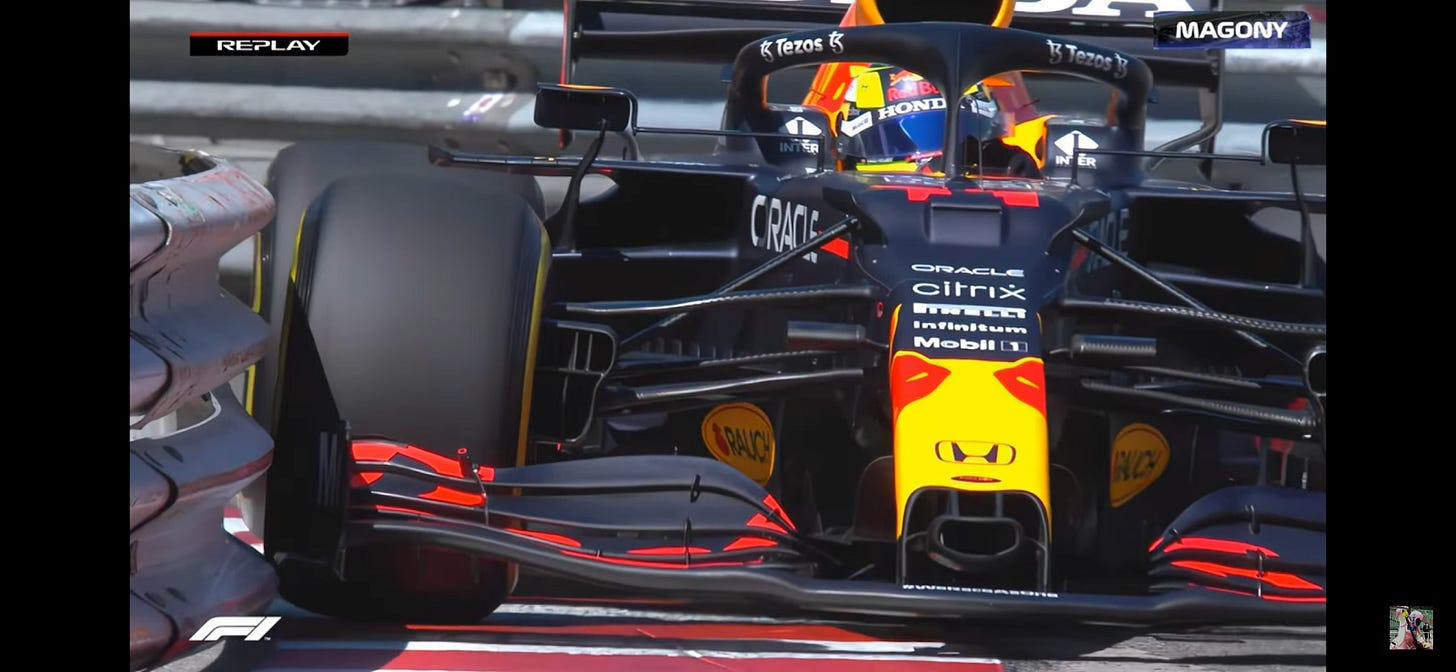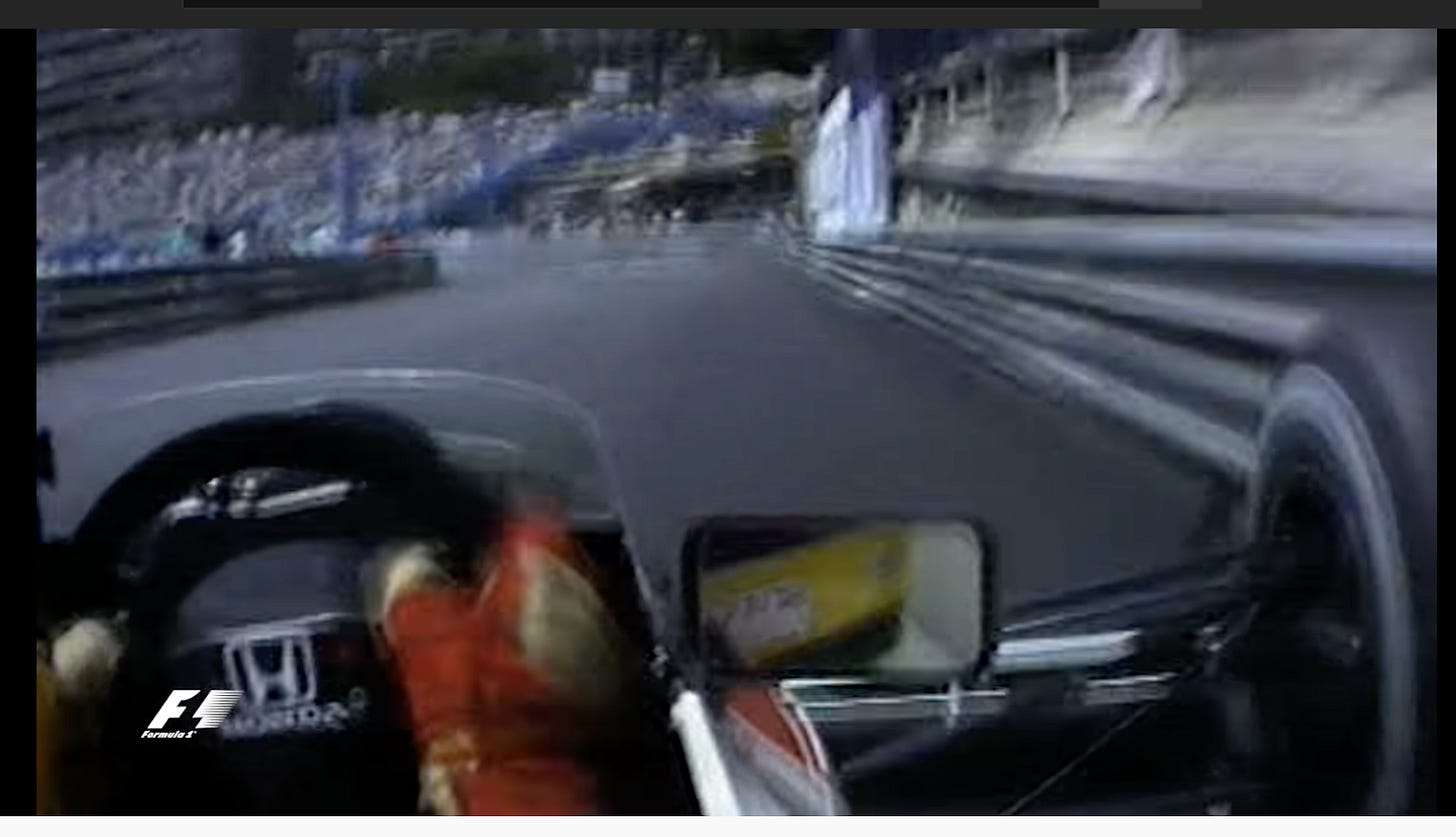The Spatial Memory Edition
On F1, Athletes, and the memory palace
Noah here. In the lead-up to last week’s Monaco Grand Prix, F1 driver Sergio Perez took a corner pretty tight in practice. This isn’t unusual, as Formula 1 is a sport where cars are often separated by hundredths of seconds, but Monaco is the narrowest track of the season and when I say he took it close, I really mean he took it close.
To be able to have the spatial awareness to drive a very wide car at insanely high speeds while you’re basically laying down in the cockpit is amazing on its own. To still know where the barrier is to the millimeter is a whole other level. But it also seems baked into many of the top athletes in F1 and other sports. There’s a great story of the Brazilian F1 star Ayrton Senna crashing out of a race and insisting that the wall had moved. His race engineer, Pat Symonds, recounted the story in 1984:
I said, ‘Yeah, sure it did…’ They were huge great concrete blocks…But he was so insistent, and I had so much confidence in the guy, that I said, ‘Ok, we´ve just got to go and look at this’. I did think he was talking bollocks but he needed to go and see it. So we walked out to where he´d hit the wall and do you know what? The wall had moved. I was made of the great big concrete blocks that they used to delineate the circuit, but what be happened was that someone had hit the far end of a block and pushed it, which made the leading edge come out a few millimetres. He was driving with such precision that those few millimetres, and I´m talking probably ten millimetres, were enough for him to hit the wall that time rather than just miss it”.
Why is this interesting?
To suggest some of the greatest athletes on earth have excellent spatial awareness is hardly controversial. You can’t compete at the highest level of any sport without being able to move through space with precision. But there’s a connected piece of their skill that I’ve always wondered about, and that’s memory.
The story of Senna isn’t just about knowing where your car is, it’s about remembering every bit and bump in the track. In basketball, LeBron James regularly rattles off six minutes of plays down to the pass and dribble. Tennis stars frequently do the same. And, probably least surprising of all, there is the recent video that made the rounds of chess grandmaster Magnus Carlson recognizing chess games by looking at a single position.
What I wonder is whether the two are connected. Is this a case of correlation or causation? The reason I’m so curious is that the best way to remember things—the method used by those who compete in “memory sports”—is to utilize spatial memory. They use a technique called “memory palaces” to place things around an imagined physical space. For thousands of years, we have known that the best way to remember things is to tap into the part of your brain that maps the world (that’s why you can find the knife you’re looking for in a drawer of a hundred knickknacks). Here’s how Joshua Foer described it for his book Moonwalking With Einstein, all about his quest to compete in memory sports.
The techniques of the memory palace—also known as the journey method or the method of loci, and more broadly as the ars memorativa, or “art of memory”—were refined and codified in an extensive set of rules and instruction manuals by Romans like Cicero and Quintilian, and flowered in the Middle Ages as a way for the pious to memorize everything from sermons and prayers to the punishments awaiting the wicked in hell. These were the same tricks that Roman senators had used to memorize their speeches, that the Athenian statesman Themistocles had supposedly used to memorize the names of twenty thousand Athenians, and that medieval scholars had used to memorize entire books.
It seems too convenient to imagine that it’s just coincidental that some of the people with the best spatial senses also just happen to have amazing memories. I suspect that part of what makes them so amazing on the field, court, or track, is their heightened ability to remember things. Whether the memory came first or it’s a result of tuning their spatial brain is probably impossible to know, but hopefully, we will all start to respect these stars for their brains as well as their brawns. (NRB)
Video of the Day:
If you’ve never seen this video of Ayrton Senna driving Monaco in 1990, it’s worth the minute and forty seconds. (NRB)
Quick Links:
Thinking fast, slow, and not at all: System 3 jumps the shark (NRB)
A review of the new electric F-150 (CJN)
Thanks for reading,
Noah (NRB) & Colin (CJN)
—
Why is this interesting? is a daily email from Noah Brier & Colin Nagy (and friends!) about interesting things. If you’ve enjoyed this edition, please consider forwarding it to a friend. If you’re reading it for the first time, consider subscribing (it’s free!).




Lots of F1 drivers seem to learn the tracks nowadays through computer games. And then that reminded me of this thread https://twitter.com/irondavy/status/1397560005939720194?s=21 about using games as memory palaces.
I came across Lynne Kelly on Memory Palaces while listening to Sean Carroll's podcast - it's worth listening to https://www.preposterousuniverse.com/podcast/2019/08/19/60-lynne-kelly-on-memory-palaces-ancient-and-modern/